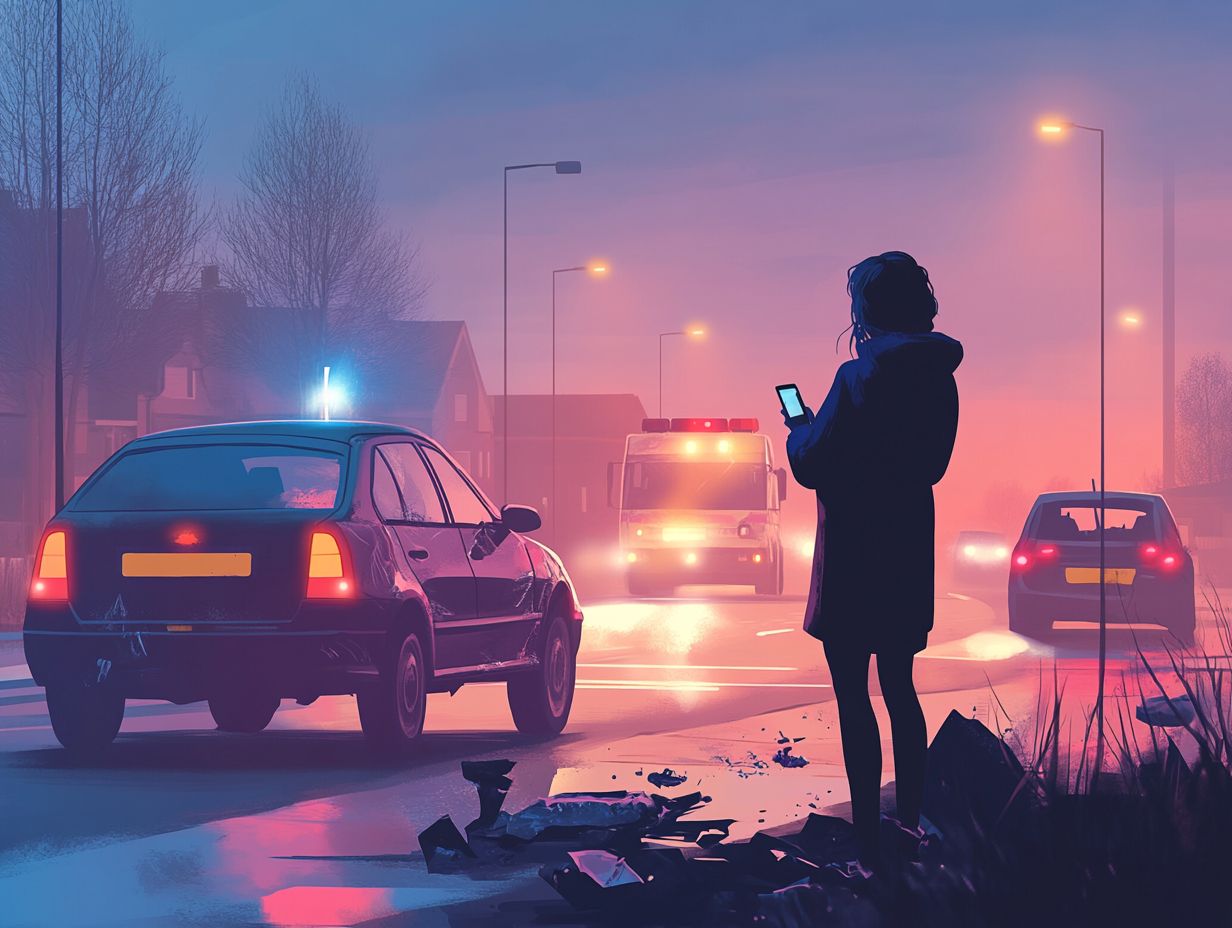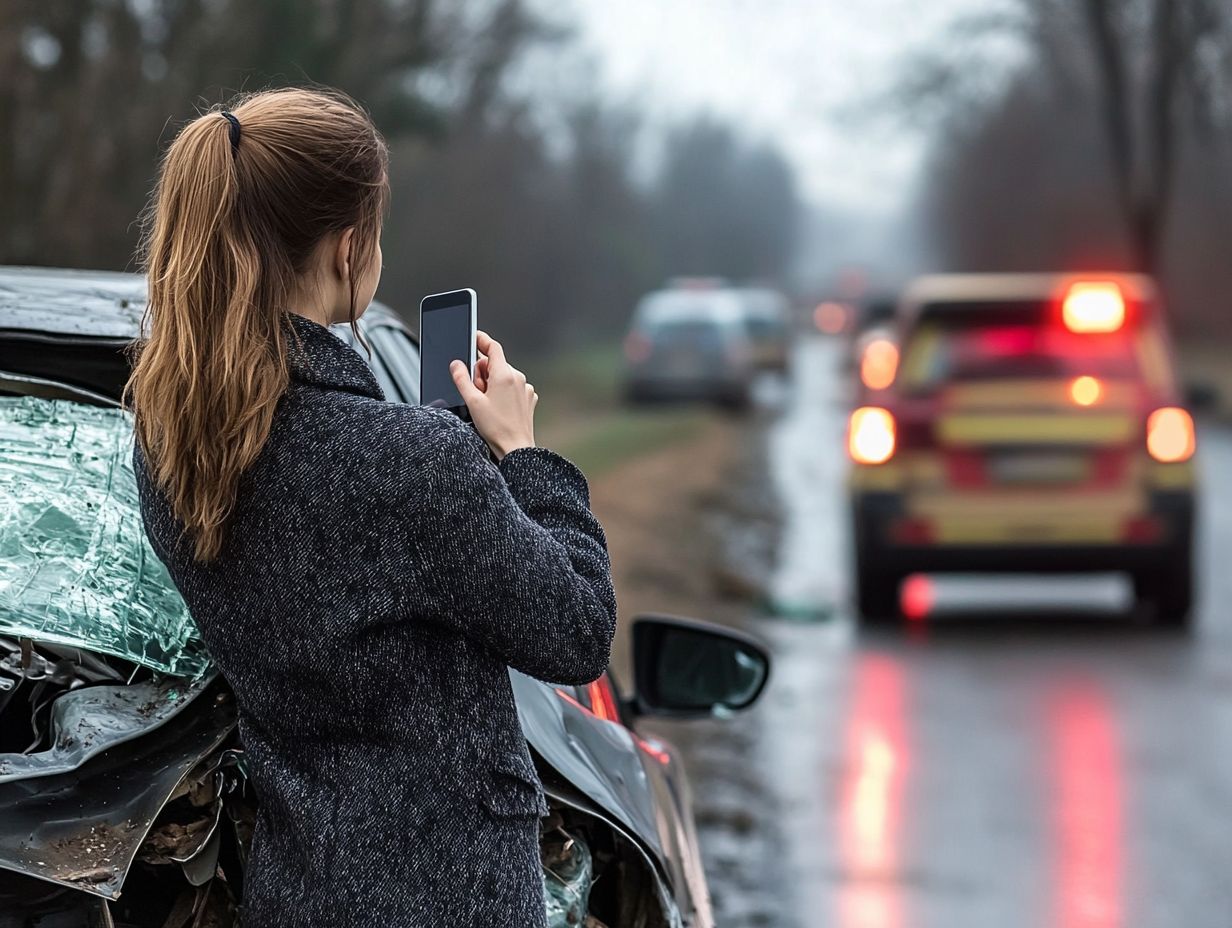What Are the Steps After a Hit-and-Run?
A hit-and-run accident can be both alarming and disorienting, leaving you unsure of your next steps.
Understanding the definition and legal implications is essential. Knowing the immediate actions to take after the incident is equally important.
Reporting the accident, seeking medical attention, and gathering evidence for law enforcement are all critical steps you must take.
Filing an insurance claim and exploring your legal options can help you navigate the aftermath effectively. You ll also discover tips to help prevent such incidents in the future.
Don t wait! Learn how to handle a hit-and-run situation confidently with our expert tips.
Contents
Key Takeaways:

- Always report a hit-and-run incident to the police and seek medical attention immediately. Time is crucial for gathering evidence and seeking justice.
- Collect witness statements and other evidence at the scene of the accident. This can greatly help in identifying and locating the hit-and-run driver.
- If you are a victim of a hit-and-run, you have legal options such as suing the driver and seeking compensation. Taking legal action can help you get the justice you deserve.
What is a Hit-and-Run?
A hit-and-run happens when a driver, after being involved in a car accident, abruptly leaves the scene without offering their contact information or assisting those who may be injured. This act is illegal and can result in serious legal consequences under Indiana law.
As a victim of such an incident, you may encounter numerous challenges, including dealing with personal injuries, seeking medical care, and navigating the complexities of filing an injury claim against a driver who is nowhere to be found.
Often, police investigations will be launched to collect evidence and identify the driver who fled. This highlights the critical role of an accident report and witness statements in this process.
Definition and Legal Consequences
A hit-and-run accident is classified as a civil offense where you, as the driver, fail to stop and provide the necessary information after a collision. This act showcases a lack of responsibility and can lead to significant legal repercussions.
In many jurisdictions, the law treats hit-and-run incidents as misdemeanors or even felonies, depending on the severity of the accident and whether someone was injured. If you find yourself convicted, you could face penalties that include hefty fines, license suspension, and even the possibility of imprisonment.
As a victim of such an accident, you have the legal right to pursue compensation for medical expenses, lost wages, and pain and suffering through a personal injury lawsuit, which is a legal claim for damages. This can aid in your recovery from the unfortunate aftermath.
Immediate Actions to Take
In the unfortunate event that you find yourself in a hit-and-run or any car accident, your first course of action should be to notify emergency services and seek medical attention. Your health and safety are the most important.
Documenting the details of the accident and gathering evidence will prove essential for your injury claim and the police report. It s vital that you stay at the scene to assist authorities and provide any witness information.
Reporting the Incident
Reporting the incident to the police after a hit-and-run is absolutely essential. They will generate an accident report that serves as critical documentation for both your insurance company and any potential injury claim you may pursue.
When you file this report, be meticulous in providing comprehensive details. Include the time and location of the incident, a description of the other vehicle, witness statements, and any visible injuries. This information not only assists law enforcement in their investigation but also strengthens your position when negotiating with your insurance provider.
The documentation you gather can significantly impact how your claim is processed and whether you receive compensation for damages.
In these circumstances, having collision insurance becomes paramount. It covers repairs to your vehicle even if you cannot identify the at-fault driver, ensuring you remain financially secure during what can be an incredibly stressful time.
Get Medical Help Right Away

Get medical help right away after a hit-and-run. Injury symptoms might not show up immediately, but prompt treatment can significantly impact your recovery and any personal injury claims you may pursue.
As an accident victim, you may experience a range of injuries like whiplash, concussions, and soft tissue damage. These injuries may not reveal themselves for days or even weeks. That s why visiting a healthcare professional right after the incident is essential. This allows for early detection and treatment of issues.
Keeping meticulous medical records is vital to support any injury claim against the responsible driver or their insurance company. These records document the injuries you’ve sustained and create a clear timeline of your treatment and recovery, reinforcing the legitimacy of your claims and potentially influencing settlement outcomes.
Gathering Evidence for the Police
Gathering evidence for the police is a crucial step after a hit-and-run. It plays an important role in identifying the driver who fled and bolstering your injury claim.
Key pieces of evidence may include:
- witness information
- photographs of the collision
- any security camera footage that captured the accident scene
Collecting Witness Statements and Other Evidence
Collecting witness statements and other evidence from the accident scene is essential to strengthen your case after a hit-and-run incident.
Gather details like the names, contact information, and accounts of witnesses. This significantly enhances the credibility of your claim. Note the time and location of the incident, along with descriptions of the vehicles or individuals involved. These details help law enforcement piece together the circumstances surrounding the accident and provide concrete evidence of what occurred.
The more comprehensive your information collection is, the stronger your case will be. Thorough evidence gathering is a vital step in the process.
Filing an Insurance Claim
Filing an insurance claim after a hit-and-run is crucial for securing compensation for your injuries and damages.
This process requires thorough documentation of the accident and clear communication with your insurance company. Taking these steps ensures that you are well-prepared to navigate the claims process effectively.
Steps to Take for Compensation
To pursue compensation for a hit-and-run, it s essential to understand the steps involved in filing an injury claim. This may involve using your insurance coverage or pursuing a claim against a driver without insurance.
Start by gathering important documents, such as accident reports, medical records, and witness accounts. Promptly report the incident to both the police and your insurance company. Timely reporting can significantly influence the outcome of your claim. While navigating the claims process can feel daunting, being organized and meticulous will benefit you.
A hit-and-run can lead to significant costs, including medical expenses, lost wages, and emotional distress. These factors highlight the importance of diligently following each step to ensure a successful resolution.
Legal Options for Hit-and-Run Victims

As a hit-and-run victim, you have various legal options to pursue justice and seek compensation. One option is to file a personal injury lawsuit against the responsible party, if they can be identified.
Don t wait; get the help you need now!
Suing the Driver and Seeking Justice
Suing the driver in a hit-and-run can be complex but is essential to pursue justice and recover damages for your injuries.
To start this process, you need to gather strong evidence, such as witness statements, police reports, and any available video footage to support your case. Your lawsuit usually relies on the idea of carelessness, where the fleeing driver’s actions directly led to your harm.
You can claim various types of damages, including medical expenses, lost wages, and pain and suffering. These damages can have a significant impact on your life after the incident.
Given the complexities of legal proceedings, hiring an experienced lawyer is crucial. Their expertise will guide you through the legal maze, ensuring you receive the compensation you deserve.
Preventing Hit-and-Runs
Preventing hit-and-runs requires awareness of your driving environment and a commitment to safe driving practices. This includes following traffic laws and avoiding dangerous driving habits.
By staying alert and responsible on the road, you can increase your safety and contribute to a more secure driving experience for everyone.
Tips for Staying Safe on the Road
Stay alert and take action to keep yourself safe on the road! Understand the risks that dangerous driving poses.
Always practice defensive driving, like keeping a safe distance and watching for potential hazards. Being aware of your surroundings helps you react quickly to sudden changes, such as pedestrians stepping onto the roadway or vehicles making sudden moves.
Use strategies like signaling well in advance and checking your blind spots to improve your overall road safety. Remember to avoid distractions from mobile devices or other activities, and focus on responsible driving. This protects not only you but everyone else on the road.
Frequently Asked Questions
What are the steps after a hit-and-run?

- Check for injuries and call for medical assistance if needed.
- Call the police and file a report.
- Gather evidence, like witness statements and surveillance footage.
- Contact your insurance company and provide the necessary information.
- Keep track of any medical treatment or expenses related to the hit-and-run.
- Consider hiring a lawyer to assist with the legal process.
Should I chase after the driver who hit me?
No, it is not safe to chase a hit-and-run driver. This can put you in danger and may hinder any potential legal action.
What if I don’t have insurance or the driver who hit me doesn’t have insurance?
If you lack insurance, you may have to use your own funds for any expenses. If the other driver is uninsured, you might need to file a lawsuit against them to seek compensation.
Can I still file a claim if I don’t know who hit me?
Yes, you can file a claim with your insurance company even if you don t know the other driver s identity. However, recovering compensation may be more challenging without this information.
What if the hit-and-run driver is caught?
If the hit-and-run driver is caught, you can file a claim against their insurance or pursue legal action for damages.
What if I am at fault for the hit-and-run?
If you are at fault for the hit-and-run, you could face legal penalties and may be responsible for paying for any damages or injuries caused by the accident.






